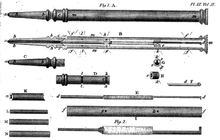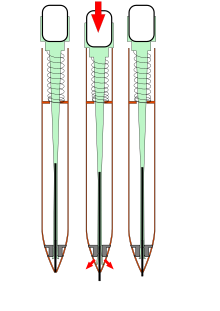Mechanical pencil

A mechanical pencil , the case pencil or mine Schreiber (rarely also mechanical pencil ) was used instead of by sharpening regularly ablated timber casing for the writing lead a reusable shell of plastic or metal . In contrast to pencils and colored pencils with a wooden jacket, a pencil extender is therefore never required, because the handling remains the same regardless of the lead length.
history

The earliest surviving example of a mechanical pencil was found in the wreckage of the HMS Pandora , which sank in 1791 . In 1822, Sampson Mordan and John Isaac Hawkins received the first patent for a refillable pencil in Great Britain . After he had bought out Hawkins, Mordan sold the pencil between 1823 and 1837 together with his partner Gabriel Riddle under the brand "SMGR". After the end of the partnership, Mordan produced the pencils under the name "S.MORDAN & CO." The company produced until the Second World War when the factory was destroyed by a bomb attack.
In total, more than 160 patents were issued between 1822 and 1874 on numerous different improvements to mechanical pencils. The first pen with a spring device was patented in 1877, and a rotating mechanism was developed in 1895.
In 1915 Tokuji Hayakawa brought a fine lead pencil to the market in Japan under the name Ever-Ready Sharp Pencil , which was based on a screw mechanism. However, it was not successful until a company from Yokohama placed a bulk order. The pen later gave the manufacturer its name: Sharp .
The immediate forerunner of today's most widespread variant (with clamp pliers) was an invention of the American Charles Rood Keeran . In 1913 he applied for a patent for his development, which was registered in 1915. From this point on, Keeran's pens were sold under the brand name Eversharp .
Today's form
The most common form of a mechanical pen today uses leads with a thickness of 0.2 mm to 1.18 mm, which are held in a guide by clamping pliers. The lead is advanced a few millimeters by slightly opening the clamping pliers using the push button on the pen head or on the side surface. Additional leads can be stored in the jacket of the pen. The guide can be rigid or spring-loaded, depending on the application in the technical or, more rarely, in the artistic field. The usual length of the leads is 60 mm.
Mechanical pencil
The mechanical pencil (also: TK pencil ) is the forerunner of the fine lead pencil and is similar to it, but the leads are thicker (typically: 2 mm; up to 6 mm) and longer. Pliers in the tip of the pen hold the lead in place. It can be released at the push of a button so that the mine falls out. There are pencil leads in all degrees of hardness and colored pencil leads to match the pens .
The lead is sharpened with sandpaper or with a special sharpener (also Dahle , Spitzmühle , Gedess ). Some pens have a sharpener built into the cap.
Clutch pencils were widespread in the 1970s and 1980s; today mechanical pencils are more common. Clutch pencils are mainly used for drawing and sketching. The particular advantage is that the lead can be sharpened or ground differently depending on the application (e.g. chisel-shaped for drawing lines). In addition, the leads are more break-proof than the usually thinner leads of mechanical pencils.
Other variants
- The mechanical pencil or filling pencil achieves the advance of the lead through a rotating mechanism of the pencil instead of the push button.
- There are multi-function devices, especially combinations of mechanical pencils and ballpoint pens .
- Some mechanical pencils or mechanical pencils have an integrated eraser at the top, which often serves as a cover for the lead reservoir.
- Some mechanical pencils have a needle on this eraser that corresponds to the thickness of the leads used. This needle can be used to loosen any jammed material from the tube at the tip of the pencil.
- The tube at the tip of the mechanical pencil is quite sensitive, especially with small lead thicknesses. B. bend in a pocket. High-quality mechanical pencils therefore often have a mechanism that can sink the tube into the pen body when the pen is not in use.
- When writing or drawing with a mechanical pencil, the lead tip quickly becomes wedge-shaped, which affects the line thickness. It is therefore not uncommon for technical drawings in particular to turn the pen a little after each stroke. For this reason, a Japanese manufacturer has developed a mechanical pencil that uses a mechanical clutch to automatically turn the lead a little further each time it is put on, making the tip conical. (Mitsubishi: Uni Kuru Toga )
Web links
- Dave's Mechanical Pencils
- Leadholder.com, the Online Drafting Pencil Museum
- The Cult Pens Guide to Mechanical Pencils
- MoonWiki - Mechanical Pencil Database
Individual evidence
- ↑ National Geographic Magazine, Vol. 168, No. 4 (Oct 1985), p. 450.
- ↑ History of Lead Holders . Leadholders.com. January 4th, 2008. Archived from the original on August 24th, 2007. Info: The archive link was inserted automatically and has not yet been checked. Please check the original and archive link according to the instructions and then remove this notice. Retrieved February 27, 2008.
- ↑ Sampson Mordan Pencils . Mark Hill Collects: The 20th Century Design and Collectibles Blog. April 30, 2009. Retrieved December 12, 2009.




